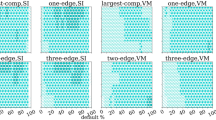Abstract
Filiz et al. (in arXiv:0809.1393 (2008)) proposed a model for the pattern of defaults seen among a group of firms at the end of a given time period. The ingredients in the model are a graph G=(V,E), where the vertices V correspond to the firms and the edges E describe the network of interdependencies between the firms, a parameter for each vertex that captures the individual propensity of that firm to default, and a parameter for each edge that captures the joint propensity of the two connected firms to default. The correlated default model can be rewritten as a standard Ising model on the graph by identifying the set of defaulting firms in the default model with the set of sites in the Ising model for which the {±1}-valued spin is +1. We ask whether there is a suitable continuous-time Markov chain (X t ) t≥0 taking values in the subsets of V such that X 0=∅, X r ⊆X s for r≤s (that is, once a firm defaults, it stays in default), the distribution of X T for some fixed time T is the one given by the default model, and the distribution of X t for other times t is described by a probability distribution in the same family as the default model. In terms of the equivalent Ising model, this corresponds to asking if it is possible to begin at time 0 with a configuration in which every spin is −1 and then flip spins one at a time from −1 to +1 according to Markovian dynamics so that the configuration of spins at each time is described by some Ising model and at time T the configuration is distributed according to the prescribed Ising model. We show for three simple but financially natural special cases that this is not possible outside of the trivial case where there is complete independence between the firms.
Similar content being viewed by others
References
Bluhm, C., Overbeck, L., Wagner, C.: An introduction to credit risk modeling. Chapman & Hall, London (2002)
Bielecki, T., Rutkowski, M.: Credit Risk: Modeling, Valuation and Hedging. Springer, Berlin (2002)
Collin-Dufresne, P., Goldstein, R.S., Helwege, J.: Is credit event risk priced? Modeling contagion via the updating of beliefs, NBER Working Paper Series, w15733. Available at http://ssrn.com/abstract=1550602 (2010)
Das, S., Duffie, D., Kapadia, N., Saita, L.: Common failings: How corporate defaults are correlated. J.Finance 62, 93–117 (2007)
Davis, M., Lo, V.: Infectious defaults. Quant. Finance 1, 382–387 (2001)
Davis, M., Lo, V.: Modeling default correlation in bond portfolios. In: Alexander, C. (ed.) Mastering Risk Applications, vol. 2, pp. 141–151. Prentice Hall, New York (2001)
Duffie, D., Singleton, K.J.: Credit risk: Pricing, Measurement, and Management. Princeton University Press, Princeton (2003)
de Servigny, A., Renault, O.: The Standard & Poor’s Guide to Measuring and Managing Credit Risk. McGraw–Hill, New York (2004)
Errais, E., Giesecke, K., Goldberg, L.R.: Pricing credit from the top–down with affine point processes. In: Miller, J.J.H., Edelman, D.C., Appleby, J.J.H. (eds.) Numerical Methods for Finance, pp. 195–201. Chapman & Hall, London (2007)
Ehlers, P., Schönbucher, P.J.: Background filtrations and canonical loss processes for top–down models of portfolio credit risk. Finance Stoch. 13, 79–103 (2009)
Onur Filiz, I., Guo, X., Morton, J., Sturmfels, B.: Graphical models for correlated defaults. arXiv:0809.1393v1 (2008)
Frey, R., McNeil, A.J.: Dependent defaults in models of portfolio credit risk. J. Risk 6, 59–92 (2003)
Giesecke, K., Goldberg, L.R., Ding, X.: A top–down approach to multi-name credit. To appear in Operations Research. doi:10.1287/opre.1100.0855. Available at http://ssrn.com/abstract=1142152 (2009)
Giesecke, K.: A simple exponential model for dependent defaults. J. Fixed Income 13, 74–83 (2003)
Giesecke, K.: Correlated default with incomplete information. J. Bank. Finance 28, 1521–1545 (2004)
Giesecke, K.: Credit risk modeling and valuation: An introduction. In: Shimko, D. (ed.) Credit Risk: Models and Management. Riskbooks, vol. 2, pp. 487–526 (2004)
Giesecke, K., Weber, S.: Cyclical correlations, credit contagion, and portfolio losses. J. Bank. Finance 28, 3009–3036 (2004)
Giesecke, K. Credit contagion and aggregate loss. J. Econ. Dyn. Control 30, 741–761 (2006)
Hull, J., White, A.: Valuing credit default swaps II: Modeling default correlations. J. Deriv. 8, 12–22 (2001)
Jorion, P., Zhang, G.: Good and bad credit contagion: Evidence from credit default swaps. J. Financ. Econ. 84, 860–883 (2007)
Kitsukawa, K., Mori, S., Hisakado, M.: Evaluation of tranche in securitization and long-range Ising model. Physica A 368, 191–206 (2006)
Laurent, J.-P., Gregory, J.: Basket default swaps, CDOs and factor copulas. J. Risk 7, 2005 (2003)
Molins, J., Vives, E.: Long range Ising model for credit risk modeling in homogeneous portfolios. AIP Conf. Proc. 779, 156–161 (2005)
Schmid, B.: Credit Risk Pricing Models: Theory and Practice, 2nd edn. Springer, Berlin (2004)
Schönbucher, P.J., Schubert, D.: Copula-dependent default risk in intensity models. Working paper, Department of Statistics, Bonn University. Available at http://ssrn.com/abstract=301968 (2001)
Wagner, N. (ed.): Credit Risk: Models, Derivatives, and Management. Chapman & Hall, London (2008)
Yu, F.: Correlated defaults in intensity based models. Math. Finance 17, 155–173 (2007)
Zhou, C.: An analysis of default correlations and multiple defaults. Rev. Financ. Stud. 14, 555–576 (2001)
Zhu, S.H., Pykhtin, M.: A guide to modeling counterparty credit risk. GARP Risk Rev. 37, 16–22 (2007)
Author information
Authors and Affiliations
Corresponding author
Rights and permissions
About this article
Cite this article
Evans, S.N., Hening, A. Nonexistence of Markovian time dynamics for graphical models of correlated default. Queueing Syst 69, 293–312 (2011). https://doi.org/10.1007/s11134-011-9261-y
Received:
Revised:
Published:
Issue Date:
DOI: https://doi.org/10.1007/s11134-011-9261-y




